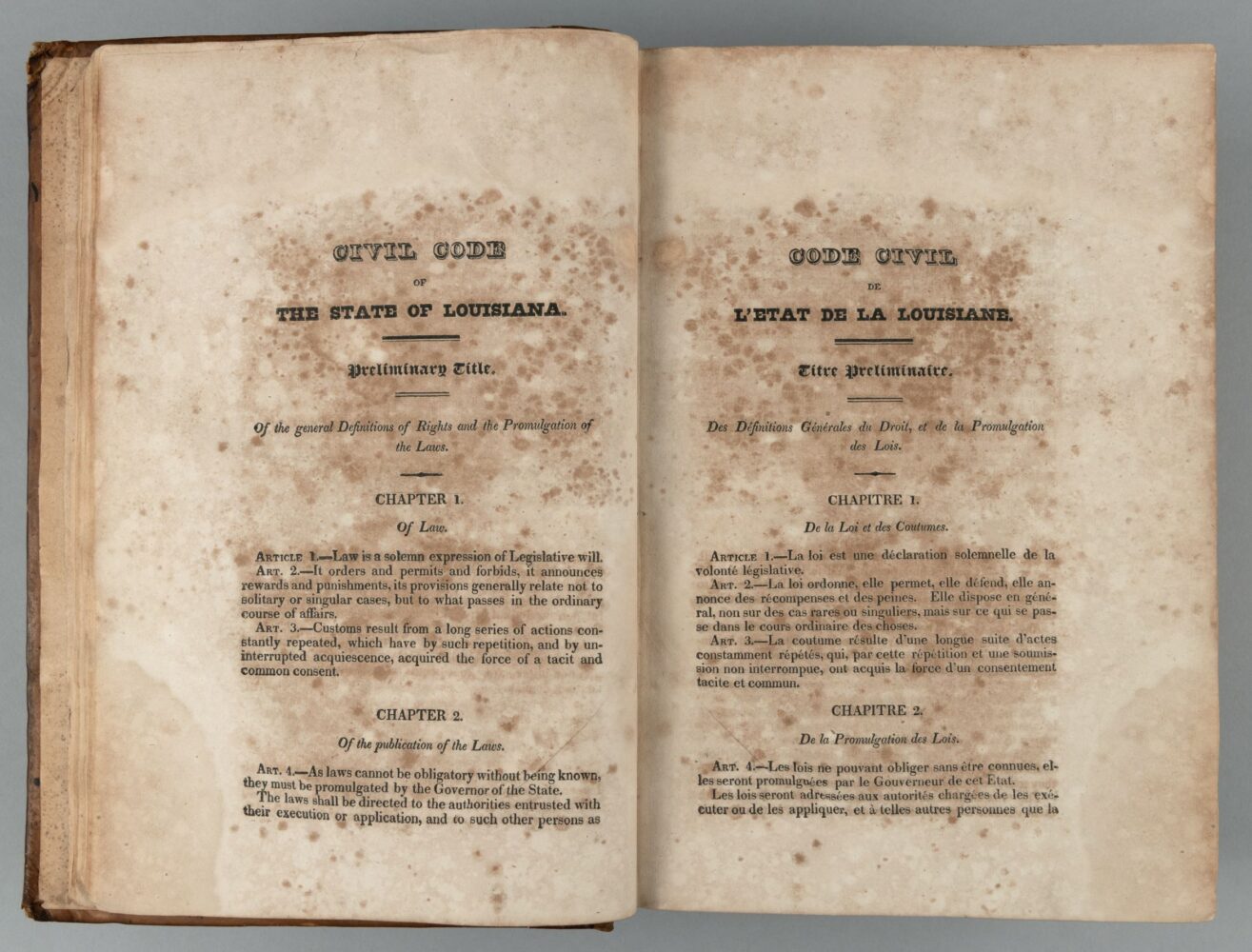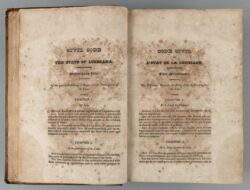Napoleonic Code
The French Civil Code of 1804 standardized civil law in France, becoming a model legal framework for jurisdictions around the world, including Louisiana.

The Historic New Orleans Collection
An interior spread from the Civil Code of the State of Louisiana, featuring an English translation on one page and French on the opposite page.
The Napoleonic Code, Code Napoléon, or French Civil Code of 1804 is the foundation of French private law both at the time of its enactment and today. It is, in part, a product of the revolutionary, nationalist spirit in France at the time of its enactment, as well as an Enlightenment belief that rules and principles to govern everyday life can be rationally deduced and laid out in general statements. The substance of the Napoleonic Code is a blend of revolutionary innovation and customary law that prevailed in large parts of France in the early nineteenth century and written Roman law that was prevalent throughout large parts of Europe at the time. The code’s scope of application is broad, governing a wide spectrum of legal interactions between private citizens, including property, contracts, sales, leases, and wills. Perhaps just as important, the Napoleonic Code has served the model for private law in jurisdictions as far away as in Africa, Asia, South America, and Europe and as close by as Quebec and Louisiana.
History
Organizing private law into a comprehensive code is a relatively recent phenomenon. Although codification is often mistaken as a characteristic difference between civil law (i.e., the system of private law that prevails in much of Europe and Latin America) and common law (i.e., the private law system employed in the English-speaking world), it is not a definitional characteristic of civil law. Roman law, the foundation of civil law, was not codified nor are the private laws today of South Africa, which are largely influenced still by Roman-Dutch law. In general, codification is a product of Enlightenment thought, which, as Konrad Zweigert and Hein Kötz describe, argues for a deliberate, comprehensive, and rational system of laws.
Civil law systems have historically adopted codification more readily than common law systems, although codification did not always prevail. Prior to the Napoleonic Code, French law was highly variegated. Southern France was primarily known as the region of the written law (pays de droit écrit) because of the prevalence and binding effect of written Roman law that governed the area at the time. Northern France, including Paris, was known as the pays de droit coutumier, or the region of the customary law because of the prevalence of Frankish and Germanic customary law, much of which was oral. In fact, laws prior to the French Revolution (1789–1799) were so fragmented that Voltaire reputedly quipped that in riding through the country one changed laws as often as one changed horses.
After the revolution, the push for codification grew, as France was ill served by varying laws that aided neither national integration nor the interests of citizens, whose rights changed from one locale to the next. Moreover, the revolutionary cause of liberté, égalité, fraternité—liberty, equality, fraternity—was antithetical to a confused state of laws and their inconsistent application. After the revolution, a politically unified country required a unified law.
The Napoleonic Code consequently embodied Enlightenment thinking and was motivated by post-revolutionary sentiment. Although it was not the first enacted civil code, it was the most influential one. Earlier codification attempts had been made in Austria in the mid-to-late 1700s and had succeeded in Prussia in 1794. In fact, earlier codification efforts had even been attempted in France before the Napoleonic Code’s enactment. From as early as 1790, multiple attempts and commissions failed to spread a binding civil code for France.
Napoleon’s singular influence proved the catalyst for accomplishing the task. His strong will and political acumen were essential to enacting the civil code, and his influence is evident in areas of law like divorce and adoption. The work of drafting a civil code, however, was largely accomplished by a commission. In 1800, Napoleon appointed a group of four experienced legal practitioners: François Tronchet (president of France’s supreme court for private law matters), Félix Bigot de Préameneu (a lawyer in the French government), Jacques de Malleville (a judge), and Jean Portalis (an administrative official). In only four months, the commission produced a draft of the civil code.
The original draft faced fierce criticism as a product of unoriginal thinking and as a slavish copy of Roman and customary law. In a political calculation, Napoleon withdrew the draft only to reintroduce it later and succeed in having it enacted in thirty-six separate statutes between 1801 and 1803. On March 21, 1804, the individual statutes were consolidated into a single Code Civil des Français. In 1807, the name was officially changed to the Code Napoléon in recognition of Napoleon’s role in its passage and enactment. In 1816, the name was changed back to eliminate the reference to Napoleon, only to have his recognition restored in 1852 by virtue of a decree by Napoleon III. Today, “Code Napoléon,” or Napoleonic Code, refers to the original 1804 text rather than subsequent revisions. Since 1870, however, it is referred to as the Code Civil, or French Civil Code.
Scope and Application
The French Civil Code consists of 2,281 articles and is comprised of three separate sections or “books,” each of which—in classical Enlightenment thinking—follows logically one from another. Book I outlines “persons,” as the rights they have must be considered prior to considering things or property, which are discussed in Book II. Book III combines the scope of the first two books in that it concerns the rights that persons have in things, including rights acquired by contracts, sales, successions, and other manners.
Book I regulates institutions such as marriage, guardianship, and tutorship, as well as the family, which was then considered the basic institution of civilized society. Despite the revolutionary spirit that, in part, motivated codification, family laws were largely conservative and traditional. They still treated the father as the head of the family, even though the revolution achieved equality for women. Although divorce was recognized, it was not easily allowed. Adultery and cruel treatment were legitimate bases for divorce, but the more permissive approach that had been prevalent during revolutionary times was rejected. Divorce by mutual consent was only accepted as a last-minute addition and by the influence of Napoleon himself.
Book II is sometimes interpreted as adopting revolutionary principles for property law, unlike the approach taken toward the family in Book I. As André Tunc writes, property ownership was defined as “a complete, absolute, free and simple right”; its key provision was expressed as an individual and absolute right for all and contained no preferred rights for privileged classes that had existed prior to the revolution. However, some scholars caution that the principles of revolutionary individualism found in Book II are overstated and were only first discovered in later commentaries that superimposed such beliefs.
Book III, which has been characterized as a grab bag of various types of legal transactions, stayed true to tradition while making some important changes regarding torts and general and special contracts. As a general matter, this area of law developed over centuries and was largely unchanged after the revolution. Although the civil code did adopt a strong guiding principle of freedom of contract, other areas of contract law, such as the law of sales, are strongly influenced by their traditional Roman origins. Book III also governs successions, donations, and wills, and the drafters innovated by rejecting old conceptions of preference for first-born children and male heirs. Book III embraced the freedom to dispose of property by will but balanced the idea of individual freedom with concepts of family solidary and with the obligation of leaving property to children after death.
Although the French Civil Code was comprehensive, rational, and logical, it was not an attempt to specify the details of all rules governing human interactions. Rather, care was taken not to over-legislate every aspect of life. Instead, the civil code was more appropriately seen, as A. N. Yiannopoulos writes, as a “complete legislative statement of principles” that displaced prior law and the need to resort to other sources. Any gaps would be filled by logical and rational reasoning and analogy to other provisions of the code.
Over the last two hundred years, the French Civil Code has endured. Given changes in society and technology, some revisions have been necessary, but no comprehensive revision has ever occurred. Between the 1960s and 1980s, partial changes were made to laws relating to family, spouses, and successions, and further changes were made after 2000 to the law of successions and, most recently, the law of contracts. Gaps have inevitably been discovered and filled with supplemental codes and legislation on specialized topics, as well as with judicial decisions and academic commentary. While the French Civil Code has adapted to modern times, it retains its essential, Napoleonic character.
Influence in Louisiana and Elsewhere
The French Civil Code was adopted in a variety of European jurisdictions, either through export to jurisdictions that were or had been colonies or through imposition by means of conquest in areas such as Belgium, Luxembourg, the Netherlands, Italy, and various Germanic territories. The influence of the French Civil Code spread even further as it became a model for jurisdictions codifying their own laws in the early twentieth century. These jurisdictions include European countries such as Italy, the Netherlands, Spain, Portugal, as well as Romania and other jurisdictions on the Balkan peninsula. In Latin America, the French Civil Code was copied or emulated in codifications in Chile, Ecuador, Bolivia, Puerto Rico, and Uruguay. In the East, Egypt and Lebanon also followed the lead of the French Civil Code.
Finally, the influence of the French Civil Code even extended to North America and was important in codifications in Québec and in Louisiana, the latter being the only United States jurisdiction with a civil law system. The connection of Louisiana civil law to French civil law is natural. Not only was Louisiana a French colony first from 1699 to 1762 and then again from 1800 to 1803, but also Louisiana’s first codification occurred in 1808, a mere four years after the enactment of the Napoleonic Code. Although there remains debate whether the sources of the Louisiana Digest of 1808 were based upon Spanish or French law, there is no doubt when Louisiana revised its Civil Code in 1825, that French sources, including French academic commentary in the ensuing two decades, was heavily influential. In the 1950s, translations of French scholarship on the French Civil Code were prepared and disseminated in Louisiana, which became influential and instructive material for interpreting the Louisiana Civil Code. Even today, Louisiana courts continue to be guided by interpretations of the French Civil Code when questions occur on the meaning of its various provisions.
Given the influence that the French Civil Code has had not only in France but also abroad, perhaps Napoleon’s observation from exile in St. Helena rings true: “It is not in winning forty battles that my real glory lies…. But my Code Civil will not be forgotten, it will live forever.”
